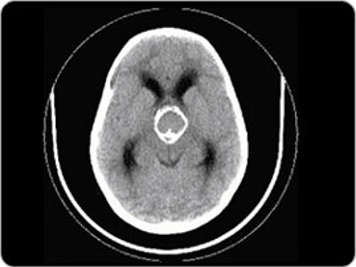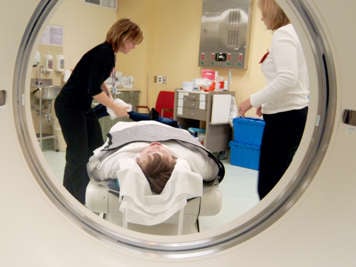Computerized tomography (CT) is a type of diagnostic imaging that uses X-rays and a computer to take cross-sectional pictures of your child's body. As it pertains to brain tumours, these cross-sectional images would be taken of your child's brain. These pictures allow doctors to see the structures inside the brain at different levels. Diagnostic imaging scans done on the brain are sometimes called neuroimaging scans or studies. The CT machine scans the brain in “slices” to produce pictures or images. Each image shows a different “slice” or level of the brain. These images or scans are interpreted by a specialized doctor called a radiologist. The length of your child’s CT scan depends on many things. A routine scan may take anywhere from five to 30 minutes, depending on the situation and well-being of the child.

Computerized tomography (CT) is a type of diagnostic imaging that uses X-rays and a computer to take cross-sectional pictures of your child's body. As it pertains to brain tumours, these cross-sectional images would be taken of your child's brain. These pictures allow doctors to see the structures inside the brain at different levels. Diagnostic imaging scans done on the brain are sometimes called neuroimaging scans or studies. The CT machine scans the brain in “slices” to produce pictures or images. Each image shows a different “slice” or level of the brain. These images or scans are interpreted by a specialized doctor called a radiologist. The length of your child’s CT scan depends on many things. A routine scan may take anywhere from five to 30 minutes, depending on the situation and well-being of the child.
Is there any preparation for a CT scan?
If your child is old enough and able to lie perfectly still for an hour, then no special preparation is usually needed for the scans. However, many children need medicine to help them sleep so they will lie still for the scan. The type of sedation your child needs depends on your child's age and medical condition. Some children have a sedative by mouth and others will receive a general anaesthetic. Before having any sedation or general anaesthetic, your child will have to be careful about what they eat or drinks. The treatment team will tell you when your child needs to stop eating and drinking before the CT. Your child may have to wear hospital clothing or a gown during the scan.
Who will be doing the CT scan?
The CT scan will be done by a team of three people. A medical radiation technologist will take the pictures of your child and assist the nurse. The nurse will help you and your child throughout the scan and give your child sedation if needed. A radiologist (a doctor who specializes in diagnostic images) will check your child’s scan before you leave to make sure it is complete.
Will my child be given any needles for the CT scan?
Children who are being sedated or are having a general anaesthetic will in most cases need to get a needle. Some CT scans give the doctor more information when they are done with a special liquid called a contrast fluid. This clear, colourless fluid is given to your child through a small tube or needle inserted into a vein in the hand or arm (intravenous or IV). The liquid is quite safe. If the physician feels that your child’s scan would be better with this liquid, it will be given partway through the study.
What should I tell my child?
Tell your child exactly what will happen when the CT scan is being done: what they will see, hear, and feel. Here is a brief description — and remember, CT scans do not hurt, although the needle may hurt.

One parent may stay in the room with the child during the scan. You will be given a lead coat to wear. When you enter the room, you will see a table and a large white box with a hole in the middle. This is the camera. The camera makes some noise when it takes a picture, but it will not touch your child.
- The technologist will make sure that your child is lying on the table in the correct position for the CT scan. For a CT scan of the brain, your child's head will be closer to the camera. The table will then move up and into the chamber, where the pictures are taken. Your child can sleep (or pretend to sleep), or you can read them a story to help the time go faster.
- After some pictures have been taken, the physician may ask for X-ray contrast fluid to be given to your child. The contrast may make your child feel warm or experience a funny taste (some say it is like bananas). This reaction is normal and will go away quickly.
- After the camera has stopped scanning, the physician will check the pictures, ask for a few more to be taken, or decide that the CT scan is finished. It is always important for your child to keep still until the pictures have been checked and the scan is complete. When the scan is finished, the technologist or nurse will help your child off the table.
What happens after the CT scan?
If your child has had sedation, you must stay until they are awake. This can take up to two hours. The nurse will let you know when you can leave. A radiologist will review the CT scan, and a report will be sent to your doctor. Your doctor will discuss the results of the scan with you at a follow-up appointment.
If your child had a sedative, they may be sleepy, grumpy, and unsteady for four to six hours. Please check on your child carefully for about six hours after the test. Give your child only small sips of clear liquids such as water or apple juice. Your child may have a regular meal if she feels like eating. When your child is fully awake, they may return to their usual activities.
What is the difference between a CT scan and MRI?
A CT is a type of X-ray, while an MRI uses strong magnetic fields and radio waves to produce an image.
Either computerized tomography (CT) or magnetic resonance imaging (MRI) may have been used initially to diagnose a brain tumour, when it was unknown what was causing the symptoms. However, in general, an MRI study is the most useful type of scan to look at the brain and spine (central nervous system). If available, an MRI is probably more likely to be used for repeat scans once a tumour has been confirmed. A CT scan is faster, and general anaesthesia is most often avoidable. Therefore, CT scan may be needed in emergency situations, i.e., to rule out hydrocephalus or acute hemorrhage.